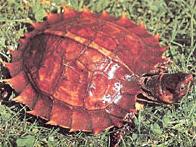Cogwheel Turtle
Asian Spiny Turtle, Spiny Hill Turtle Scientific Name: Heosemys spinosa
Fri, 4th July, 2025 - 7:11 am GMT
Sponsor Ads:

Alternative Name
Asian Spiny Turtle, Spiny Hill Turtle Scientific Name: Heosemys spinosaBasic Info
The Cogwheel Turtle is easy to recognize due to its distinctive shell, which is marked by spines on the keel and pleural scutes. The Cogwheel Turtle grows between 7 and 8.5 inches (18 and 22 cm) in length, and weighs between 3.3 and 4.5 pounds (1.5 and 2.0 kg) at maturity. They are named for their spikes, or spines though adult Cogwheel Turtles may loose their spines when they reach maturity. Young Cogwheel Turtles have been said to resemble pincushions because their spikes are so sharp. As they mature these will wear down and are not nearly as obvious as those of the young. Some adults may not have visible spikes, particularly those on the side. They can be difficult to sex. Males usually have longer, broader tails than the females. Males also have a concave plastron.
Health
Mature Cogwheel Turtles need a large enclosure with separate land and water areas. The enclosure should be very humid. The Cogwheel Turtle can also be kept outdoors when weather permits. The air temperature should be about 80 degrees Fahrenheit (27 degrees Celsius), with a warmer basking area about 90 degrees Fahrenheit (32 degrees Celsius). At night the temperature should drop to about 70 degrees Fahrenheit (21 degrees Celsius). The water should be kept at about 74 degrees Fahrenheit ( 23.5 degrees Celsius). When kept indoors, they need full spectrum UV lighting on them for about 13 hours per day. Cogwheel Turtles do well on a diet consisting mostly of fruits and dark leafy green vegetables. They also enjoy tomatoes. It is recommended that about 10% of the diet consist of meaty items such as earthworms and canned low-fat dog food (a premium brand). Breeding Cogwheel Turtles usually mate between December and February. They generally mate after the rainy season, which can be mimicked by spraying water directly on the turtles. The male then chases the female into water to mate. In captivity, females lay as many as three clutches of one or two eggs per year. They lay eggs in nests they dig. The incubation period is about 106 days, with a temperature of between 28 and 30 degrees Celsius for the first 35 days and a few degrees cooler the remaining time.Habitat
Makes its home in or near streams in rainforestsBehavior
The Cogwheel Turtle is a moderately sized turtle that is sometimes known as the Southeast Asian Spiny Turtle or the Spiny Hill Turtle. They do well in outdoor enclosures in moderate climates. Found primarily in Asia, the Cogwheel Turtle makes its home in or near streams in rainforests. The streams are usually shallow and clear. They spend a lot of time wandering on land near their streams, primarily in humid, cool, shaded spots. They are shy and spend a lot of time hiding in grass or under debris. The young turtles spend more time on land than the adults, who are more comfortable in water. They are omnivores, but feed primarily on plant matter. They are nocturnal, meaning they are active during the nighttime.Origin
AsiaHistory
Cogwheel Turtles can be found from Burma, extending down into Thailand, the Malay Peninsula, Sumatra, and Borneo.Common Foods
N/ASponsor Ads:
Lawyers are ... operators of the toll bridge which anyone in search of justice must cross. --Jane Bryant Quinn
Cogwheel Turtle
Coded by: BGID® | ALL RIGHTS RESERVED Copyright © 2000-2025
Disclaimer | Privacy | Report Errors / Contact | Credits

 Why haven't we as a collective earth met with aliens yet?
Why haven't we as a collective earth met with aliens yet?  World EcoSystem - Biodiversity Changes - Who is on board and who isn
World EcoSystem - Biodiversity Changes - Who is on board and who isn  Homosexual behavior stems from the mind or genetics?
Homosexual behavior stems from the mind or genetics?  The Best Text Adventure You Will Ever Play! The official site:
The Best Text Adventure You Will Ever Play! The official site:  Mouthwash - Mouthrinse - Mouth Sores - Healing Infections - Gingivitis
Mouthwash - Mouthrinse - Mouth Sores - Healing Infections - Gingivitis  Treatment for Depression
Treatment for Depression  Ultra radical and violent Islamist group that even rivals Al Qaeda
Ultra radical and violent Islamist group that even rivals Al Qaeda  An idea to have teachers who want to carry guns to school undergo some level of police training will be left up to local school districts and police departments.
An idea to have teachers who want to carry guns to school undergo some level of police training will be left up to local school districts and police departments.